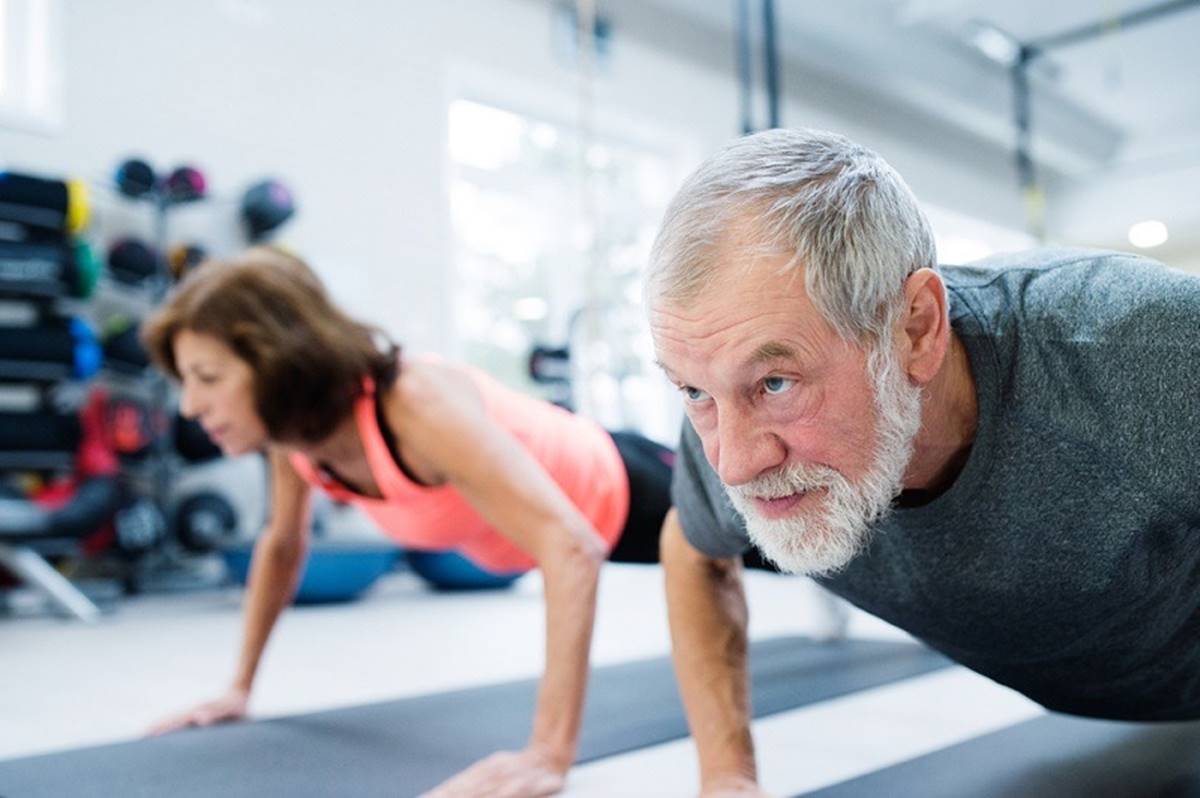

Featured
How To Lower Cholesterol With Exercise
Published: October 4, 2023
Learn how exercise can help you lower your cholesterol levels. Find out the featured techniques and tips to effectively manage your cholesterol through physical activity.
Introduction
Welcome to our comprehensive guide on how to lower cholesterol with exercise. Cholesterol is a waxy, fat-like substance that is found in the cells of your body. While your body needs cholesterol to function properly, high levels of cholesterol can increase your risk of heart disease and stroke.
Fortunately, exercise is a powerful tool in managing and reducing cholesterol levels. Engaging in regular physical activity has been shown to increase the levels of high-density lipoprotein (HDL) cholesterol, commonly known as “good” cholesterol, while decreasing the levels of low-density lipoprotein (LDL) cholesterol, often referred to as “bad” cholesterol.
In this guide, we will explore the role of exercise in lowering cholesterol and provide you with practical tips and techniques to incorporate exercise into your daily routine. Whether you’re a fitness enthusiast looking to fine-tune your cholesterol levels or just starting your journey to a healthier lifestyle, this guide is for you.
We will delve into different types of exercises that have been shown to effectively lower cholesterol, such as cardiovascular exercises, strength training, and high-intensity interval training (HIIT). Additionally, we will help you set realistic exercise goals, provide tips for starting an exercise program, and discuss important safety precautions to consider.
So let’s get started and discover how exercise can be your ally in reducing cholesterol levels, improving your overall health, and promoting a happier, more vibrant life.
Understanding Cholesterol
Cholesterol is a vital substance produced by the liver and is also found in certain foods. It plays an essential role in your body’s normal functioning, serving as a building block for cell membranes, hormones, and vitamin D. However, having high levels of cholesterol, specifically LDL cholesterol, can lead to plaque build-up in the arteries, which can restrict blood flow and increase the risk of heart disease and stroke.
When it comes to cholesterol, it’s important to understand the different types:
- Low-Density Lipoprotein (LDL) Cholesterol: Often referred to as “bad” cholesterol, LDL cholesterol carries cholesterol particles throughout your body. High levels of LDL cholesterol can lead to the accumulation of plaque in the arteries, narrowing them and increasing the risk of cardiovascular diseases.
- High-Density Lipoprotein (HDL) Cholesterol: Known as “good” cholesterol, HDL cholesterol removes LDL cholesterol from the bloodstream and transports it to the liver, where it is broken down and eliminated from the body. Having healthy levels of HDL cholesterol is beneficial for heart health.
- Triglycerides: Triglycerides are another type of fat found in the blood. High levels of triglycerides can also contribute to heart disease.
It’s important to maintain a healthy balance of these cholesterol components to reduce the risk of cardiovascular problems. Understanding your cholesterol levels is essential, so regular check-ups and cholesterol screenings are recommended, especially if you have a family history or other risk factors for heart disease.
In addition to exercise, managing cholesterol levels involves making healthy lifestyle choices, such as following a balanced diet, maintaining a healthy weight, and avoiding smoking and excessive alcohol consumption. Adopting these practices alongside regular exercise can have a positive impact on your cholesterol profile and overall cardiovascular health.
The Role of Exercise in Lowering Cholesterol
Exercise is a powerful tool in managing and lowering cholesterol levels. Regular physical activity has been shown to have a significant impact on cholesterol profiles, helping to raise levels of HDL cholesterol and lower levels of LDL cholesterol and triglycerides. Here’s how exercise plays a beneficial role in cholesterol management:
1. Increases HDL Cholesterol: Engaging in regular exercise, especially cardiovascular exercises like jogging, swimming, or cycling, can help increase the levels of HDL cholesterol in your body. HDL cholesterol acts as a scavenger, removing LDL cholesterol from the bloodstream and transporting it to the liver for disposal. By increasing HDL cholesterol levels, you can effectively reduce the accumulation of LDL cholesterol in the arteries.
2. Lowers LDL Cholesterol and Triglycerides: Exercise helps lower LDL cholesterol and triglyceride levels, which are major contributors to plaque build-up in the arteries. Aerobic exercises, such as brisk walking or running, stimulate the body to use stored fat as an energy source, thus reducing the levels of LDL cholesterol and triglycerides circulating in the bloodstream.
3. Promotes Weight Loss and Weight Maintenance: Regular exercise is an effective means of managing body weight. Excess weight and obesity are associated with higher levels of LDL cholesterol and triglycerides, making weight management crucial for maintaining a healthy cholesterol profile. Losing weight through exercise and healthy eating can lead to significant improvements in cholesterol levels.
4. Improves Heart and Cardiovascular Health: Exercise strengthens the heart and promotes better blood circulation. Regular physical activity helps to lower blood pressure and improve overall cardiovascular health, reducing the risk of heart disease and related complications.
5. Reduces Inflammation: Chronic inflammation is a significant contributor to heart disease. Regular exercise has been shown to reduce inflammation markers in the body, leading to a healthier cardiovascular system and a reduced risk of plaque formation in the arteries.
Incorporating exercise into your routine can be an effective and natural way to manage cholesterol levels. Remember that consistency is key, and it’s important to make exercise a regular part of your lifestyle to experience the long-term benefits. Pairing regular physical activity with a healthy diet and other lifestyle modifications can further enhance the impact on cholesterol levels and overall cardiovascular health.
Types of Exercise That Lower Cholesterol
When it comes to lowering cholesterol, different types of exercise can have varying effects on your cholesterol profile. Incorporating a mix of cardiovascular exercises, strength training, and high-intensity interval training (HIIT) into your routine can help maximize the benefits for managing cholesterol levels. Let’s explore each type:
1. Cardiovascular Exercises: Cardiovascular exercises, also known as aerobic exercises, are excellent for improving heart health and lowering cholesterol. These exercises increase your heart rate and breathing, challenging your cardiovascular system. Examples of cardiovascular exercises include brisk walking, jogging, cycling, swimming, dancing, and aerobics classes. Aim for at least 150 minutes of moderate-intensity aerobic activity or 75 minutes of vigorous-intensity aerobic activity per week to effectively lower your cholesterol levels.
2. Strength Training Exercises: While cardiovascular exercises are crucial for heart health, incorporating strength training exercises is equally important. Strength training builds muscle mass, which can increase your metabolism and improve your body’s ability to burn calories and fat. It also positively affects cholesterol levels by reducing LDL cholesterol and increasing HDL cholesterol. You can engage in strength training activities such as weightlifting, bodyweight exercises, or using resistance bands. Aim for two to three days per week of strength training exercises, targeting all major muscle groups.
3. High-Intensity Interval Training (HIIT): HIIT workouts involve alternating between short bursts of high-intensity exercises and brief recovery periods. HIIT is highly effective for boosting cardiovascular fitness and burning calories. Research has shown that HIIT can also improve cholesterol levels by increasing HDL cholesterol and reducing LDL cholesterol and triglycerides. These workouts can be done with various exercises such as sprints, burpees, jumping jacks, or cycling. Start with a 10-15 minute session and gradually increase the duration and intensity over time.
By incorporating a combination of cardiovascular exercises, strength training, and HIIT workouts into your routine, you can create a well-rounded exercise program that targets different aspects of cholesterol management. Remember to start gradually and listen to your body, gradually increasing the intensity and duration of your workouts over time. Consult with a fitness professional if you have any underlying health conditions or concerns about designing an exercise program that suits your needs.
Cardiovascular Exercises
Cardiovascular exercises, also known as aerobic exercises, are an integral part of any workout routine aimed at improving heart health and lowering cholesterol levels. These exercises increase your heart rate and breathing, working your cardiovascular system and helping to reduce LDL cholesterol and increase HDL cholesterol levels. Let’s explore some popular cardiovascular exercises:
1. Brisk Walking: Walking is one of the simplest and most accessible cardiovascular exercises. Brisk walking involves walking at a faster pace, enough to raise your heart rate and make you slightly breathless. Aim for at least 30 minutes of brisk walking most days of the week to reap the cholesterol-lowering benefits.
2. Jogging and Running: Taking your walking up a notch, jogging and running are excellent cardiovascular exercises that elevate your heart rate and help burn calories. Whether you prefer outdoor running or hitting the treadmill, incorporating jogging or running into your routine can effectively lower LDL cholesterol levels and increase HDL cholesterol. Start with shorter sessions and gradually increase your time and speed as your fitness improves.
3. Cycling: Cycling is a low-impact cardiovascular activity that can be enjoyed indoors on a stationary bike or outdoors on a traditional bicycle. It targets the leg muscles and effectively raises your heart rate. Cycling for at least 30 minutes a few times per week can contribute to improved cholesterol levels and overall cardiovascular health.
4. Swimming: Swimming is a fantastic full-body workout that is gentle on the joints. It engages various muscle groups and provides an excellent cardiovascular challenge. Swimming laps or participating in water aerobics classes for 30 minutes or more can help lower LDL cholesterol and increase HDL cholesterol.
5. Dancing: Dancing is not only a fun and enjoyable activity but also a great way to improve cardiovascular fitness. Whether it’s ballroom dancing, Zumba, or hip-hop, dancing gets your heart rate up and helps burn calories. Dancing for at least 30 minutes multiple times per week can contribute to improving cholesterol levels and promoting heart health.
Remember, the key to effective cardiovascular exercise is consistency. Aim for at least 150 minutes of moderate-intensity aerobic activity or 75 minutes of vigorous-intensity aerobic activity per week. Begin with a duration and intensity that suits your fitness level and gradually increase as you become more comfortable. It’s important to listen to your body and consult with a healthcare professional if you have any underlying health conditions or concerns.
Strength Training Exercises
Strength training exercises, also known as resistance training, are essential for improving muscle strength, maintaining bone density, and enhancing overall health. Incorporating strength training into your routine not only helps build lean muscle mass but also plays a crucial role in lowering cholesterol levels. Let’s explore some popular strength training exercises:
1. Weightlifting: Weightlifting involves using free weights, such as dumbbells or barbells, or weight machines to target specific muscle groups. It helps build strength and muscle mass, promoting a higher metabolic rate and aiding in fat burning. As you increase muscle mass, your body becomes more efficient at using and removing cholesterol, resulting in improved cholesterol levels.
2. Bodyweight Exercises: Bodyweight exercises use your body as resistance to build strength and muscle. These exercises include push-ups, squats, lunges, planks, and burpees. Bodyweight exercises are convenient because they can be done anywhere, with no need for equipment. They are versatile and effective for building lean muscle mass and improving overall fitness.
3. Resistance Band Training: Resistance bands are portable, affordable, and versatile tools that provide varying levels of resistance. They are excellent for strength training exercises as they target different muscle groups and allow for a wide range of movements. Resistance band exercises can be easily modified to accommodate different fitness levels and individual capabilities.
4. Pilates: Pilates is a low-impact strength training method that focuses on core stability, flexibility, and body awareness. It utilizes controlled movements to improve strength, balance, and posture. Regular Pilates practice can lead to increased muscle strength and endurance, contributing to improved cholesterol levels and overall cardiovascular health.
5. Yoga: While primarily known for its flexibility benefits, yoga also incorporates strength training elements. Certain yoga poses require muscular strength to hold and maintain stability. Regular yoga practice can help increase muscle tone, improve joint health, and promote heart health. It offers a holistic approach to fitness and complements other strength training exercises.
When performing strength training exercises, it’s important to start with proper form and technique to minimize the risk of injury. Begin with lighter weights or resistance and gradually increase as your strength and proficiency improve. Aim for two to three days per week of strength training exercises, targeting all major muscle groups.
Remember that strength training exercises not only contribute to muscle development but also play an important role in lowering cholesterol levels. Incorporate them into your exercise routine along with cardiovascular exercises for a well-rounded fitness program that supports your overall health and wellness.
High-Intensity Interval Training (HIIT)
High-Intensity Interval Training (HIIT) has gained popularity in recent years for its time efficiency and effectiveness in improving cardiovascular fitness and burning calories. HIIT involves alternating between short bursts of intense exercise and brief recovery periods. Incorporating HIIT into your exercise routine not only helps with weight management but also plays an important role in lowering cholesterol levels. Here’s why HIIT is beneficial:
1. Increased Calorie Burn: HIIT workouts are known for their high intensity and ability to elevate the heart rate quickly. This, in turn, leads to a higher calorie burn during and even after the workout due to the metabolic effect known as excess post-exercise oxygen consumption (EPOC). This means that even after you finish your HIIT session, your body continues to burn calories at an elevated rate, contributing to weight management and cholesterol reduction.
2. Improved Cardiovascular Fitness: HIIT workouts challenge the cardiovascular system by rapidly elevating and lowering the heart rate. This helps improve cardiovascular endurance and overall heart health. Regular HIIT sessions lead to adaptations in the cardiovascular system, such as increased stroke volume and improved oxygen utilization, which can positively impact cholesterol levels.
3. Reduced Insulin Resistance: HIIT has been shown to increase insulin sensitivity, meaning that your body becomes more effective at utilizing insulin to regulate blood sugar levels. By improving insulin sensitivity, HIIT workouts can help lower triglyceride levels, reduce LDL cholesterol, and increase HDL cholesterol, all of which contribute to improved cholesterol profiles.
4. Time Efficiency: One of the primary advantages of HIIT workouts is their time efficiency. With HIIT, you can achieve significant fitness benefits in a shorter amount of time compared to traditional steady-state cardio exercises. Most HIIT sessions last between 20 to 30 minutes, making it a convenient option for those with busy lifestyles who want to incorporate effective workouts into their routine.
5. Versatility and Variety: HIIT workouts are highly adaptable and can be tailored to suit individual fitness levels and preferences. You can incorporate different exercises, such as sprints, burpees, jumping jacks, or cycling, in your HIIT routine to keep things interesting and challenging. The ability to modify intensity, duration, and exercise selection allows for continued progression and prevents boredom.
Keep in mind that HIIT workouts are intense and may not be suitable for everyone, especially those with certain health conditions or injuries. It’s important to consult with a healthcare professional or certified fitness trainer before starting HIIT, especially if you are new to exercise or have any concerns. Start with shorter intervals and gradually increase intensity and duration as your fitness level progresses.
Incorporating HIIT workouts into your exercise regimen can be an effective strategy for lowering cholesterol levels, improving cardiovascular fitness, and achieving overall health and wellness.
Incorporating Exercise into Your Routine
Adopting a regular exercise routine is key to achieving optimal cholesterol levels and overall health. However, incorporating exercise into your daily routine can be challenging, especially if you have a busy lifestyle or struggle with motivation. Here are some tips to help you make exercise a habit:
1. Set Realistic Goals: Start by setting realistic and achievable exercise goals that align with your current fitness level and schedule. Be specific about the type of exercises you want to engage in, the frequency, and duration. Setting small, attainable goals will increase the likelihood of success and help you establish a consistent exercise routine.
2. Find Activities You Enjoy: Engage in physical activities that you genuinely enjoy. It’s easier to stick to an exercise routine when you’re doing something you like. Experiment with different types of exercises and find what brings you joy. Whether it’s taking dance classes, hiking, or playing a sport, find activities that make you excited to move your body.
3. Schedule Exercise Time: Treat your exercise like an important appointment by scheduling it into your daily or weekly calendar. Choose a time of day that works best for you, whether it’s early morning, during lunch break, or in the evening. Consistency is key, so aim to exercise on most days of the week to establish a routine.
4. Make it a Family or Social Activity: Exercise doesn’t have to be a solitary activity. Involve your family, friends, or colleagues in your fitness journey. Schedule group workouts, join a sports team, or even organize walking meetings. Having a support system and accountability partners can make exercise more enjoyable and help you stay motivated.
5. Be Flexible and Adapt: Life can be unpredictable, and sometimes sticking to a rigid exercise schedule can be challenging. Be flexible and adaptable with your exercise routine. If you can’t make it to the gym, find alternative ways to move your body, such as taking a walk during your lunch break or doing a quick workout at home. Remember, any form of physical activity is better than none.
6. Celebrate Your Achievements: Acknowledge and celebrate your exercise achievements, no matter how small they may seem. Rewarding yourself for reaching milestones and staying consistent can increase your motivation and help create a positive association with exercise.
7. Track and Monitor Your Progress: Keep a record of your exercise sessions and track your progress. Use a fitness tracker, smartphone app, or a journal to log your workouts, duration, and intensity. This can help you visualize your progress, identify patterns, and stay motivated by seeing how far you’ve come.
Remember, the key to incorporating exercise into your routine is consistency and finding activities that you enjoy. Gradually increase the intensity and duration of your workouts as your fitness level improves. Always listen to your body, and if you have any underlying health concerns, consult with a healthcare professional or certified fitness trainer before starting an exercise program.
Setting Realistic Goals
Setting realistic goals is essential when it comes to incorporating exercise into your routine. Realistic goals provide direction and motivation while ensuring that you maintain a healthy and sustainable approach to fitness. Here are some tips to help you set goals that are achievable and effective in promoting long-term success:
1. Be Specific: Set clear and specific goals that outline what you want to achieve. Rather than setting a vague goal like “get fit,” be specific about what that means to you, such as “being able to run a 5K race” or “completing a certain number of push-ups.”
2. Consider Your Starting Point: Take into account your current fitness level and any limitations you may have. Setting goals that are tailored to your starting point allows for a gradual progression and reduces the risk of burnout or injury. If you’re new to exercise, start with small, achievable goals and gradually increase the intensity and duration over time.
3. Set Both Short-Term and Long-Term Goals: It’s important to have a mix of short-term and long-term goals. Short-term goals can be achieved in a matter of weeks or months, while long-term goals might take several months or even years. Short-term goals provide a sense of accomplishment along the way, while long-term goals keep you focused on the bigger picture.
4. Make Your Goals Measurable: Measurement is key to tracking progress and staying motivated. Make your goals measurable by incorporating specific metrics, such as the number of workout sessions per week, the amount of weight lifted, the distance covered, or the time spent exercising. Being able to track your progress keeps you accountable and provides a tangible way to assess your achievements.
5. Be Realistic and Attainable: Avoid setting unrealistic goals that are difficult or impossible to achieve. Unrealistic goals can lead to frustration and demotivation. Be honest with yourself about your abilities and the time and effort you can realistically commit to exercise. Start with small, achievable goals and gradually increase the challenge as you progress.
6. Break Goals Down into Smaller Steps: Breaking larger goals into smaller, manageable steps can make them less daunting and more attainable. Set milestones along the way that allow you to celebrate achievements and stay motivated. Breaking goals down into smaller steps also helps to create a sense of progress and momentum.
7. Stay Flexible and Adapt: It’s important to remain flexible and adaptable with your goals. Life can throw curveballs, and circumstances may change. Be willing to reassess and adjust your goals accordingly. It’s better to modify your goals to fit the situation rather than giving up on them completely.
Setting realistic goals is a critical component of a successful exercise routine. By being specific, considering your starting point, setting measurable goals, being realistic and attainable, breaking goals down, and staying flexible, you’ll be on your way to achieving success and maintaining a healthy and sustainable fitness journey.
Tips for Starting an Exercise Program
Embarking on a new exercise program can be exciting and challenging. Whether you’re new to exercise or getting back into a routine after a break, here are some tips to help you start your fitness journey on the right foot:
1. Seek Medical Clearance: If you have any underlying health concerns or haven’t exercised for an extended period, it’s advisable to consult with a healthcare professional before starting a new exercise program. They can provide guidance on any limitations or precautions you should consider based on your individual health status.
2. Start Gradually: It’s essential to start slowly and gradually increase the intensity and duration of your workouts. This allows your body to adapt and prevents overexertion or injury. Begin with shorter, less intense sessions and slowly build up your fitness level over time.
3. Set a Schedule: Establish a regular exercise schedule that fits into your daily routine. Consistency is key in developing a habit. Block out specific times for exercise in your calendar and treat them as non-negotiable commitments to yourself.
4. Find Activities You Enjoy: Engaging in activities you enjoy increases the likelihood that you’ll stick with them long-term. Explore different types of exercise until you find activities that are enjoyable for you. Whether it’s dancing, hiking, swimming, or playing a sport, the options are endless.
5. Warm Up and Cool Down: Before and after each workout, spend a few minutes warming up and cooling down. Warming up helps prepare your body for the upcoming exercise, while cooling down allows your heart rate and breathing to return to normal gradually. This can help prevent muscle soreness and reduce the risk of injury.
6. Set Realistic Goals: Set realistic and achievable goals for your exercise program. Consider your current fitness level and lifestyle. Aiming for small, attainable goals will provide a sense of accomplishment and keep you motivated along the way.
7. Listen to Your Body: Pay attention to your body’s signals and adjust your workouts accordingly. If you feel pain or excessive discomfort, ease off or modify the exercise. Push yourself, but also respect your body’s limits to prevent injuries and promote long-term compliance.
8. Stay Hydrated: Proper hydration is crucial for overall health and exercise performance. Drink water before, during, and after your workouts to stay hydrated and replace fluids lost through sweat.
9. Get Adequate Rest: Rest days are just as important as exercise days. Allow your body time to recover and repair itself. Overtraining can lead to burnout and increase the risk of injury. Aim for at least one or two rest days per week.
10. Seek Support and Accountability: Consider finding a workout buddy or joining a fitness group to help keep you accountable and motivated. Supportive individuals can provide encouragement, share experiences, and make your exercise journey more enjoyable.
Remember, starting an exercise program is a journey. Be patient with yourself as you progress. Enjoy the process, celebrate small victories, and focus on how exercise makes you feel physically and mentally. With time and consistency, you will reap the benefits of a regular exercise routine.
Monitoring Your Progress
Monitoring your progress is a crucial aspect of any exercise program. Keeping track of your achievements allows you to stay motivated, evaluate your efforts, and make adjustments as needed. Here are some effective ways to monitor your progress:
1. Track Your Workouts: Keep a record of your workouts, including the exercises performed, sets, repetitions, and the amount of weight or intensity. Tracking your workouts allows you to see your progression over time and identify areas where you can challenge yourself further.
2. Measure Fitness Indicators: Track fitness indicators such as your heart rate, blood pressure, and resting heart rate. These measurements can provide insights into your cardiovascular fitness and overall health. Regularly monitoring these indicators can help you assess the positive impact of exercise on your body.
3. Assess Cholesterol Levels: Regularly measure and assess your cholesterol levels using blood tests. This will help you understand how your exercise program is positively influencing your cholesterol profile. Consult with a healthcare professional to interpret the results and determine the necessary adjustments in your exercise routine or lifestyle.
4. Utilize Technology: Take advantage of fitness apps, wearable devices, or smartwatches that can track various aspects of your workouts, such as steps taken, calories burned, and heart rate. These technological tools provide real-time feedback and help you stay accountable to your fitness goals.
5. Take Progress Photos: Snap progress photos regularly to visually document your fitness journey. Comparing photos over time can be a powerful visual indicator of your progress. It’s important to focus on how you feel and the improvements you’ve made rather than solely relying on physical appearance.
6. Keep a Workout Journal: Use a workout journal to write down your thoughts, feelings, and any adjustments made to your exercise routine. This serves as a valuable resource to reflect on your progress and identify patterns or areas where you can improve.
7. Evaluate Performance and Effort: Reflect on your performance and effort during workouts. Ask yourself questions like: Are you able to lift heavier weights now? Can you run longer distances or complete more repetitions? Are you pushing yourself to your full potential during workouts? Evaluating your performance and effort levels helps you gauge progress and make necessary adjustments to keep challenging yourself.
8. Set New Goals: As you achieve your initial goals, set new ones to keep yourself motivated and engaged. Continuously setting new challenges will prevent complacency and help you strive for further improvement.
Regularly monitoring your progress provides valuable insights into your fitness journey, allowing you to make informed decisions about your exercise program. Remember, progress may not always be linear, and setbacks are a normal part of the process. Celebrate your accomplishments, no matter how small, and stay committed to your long-term goals.
Safety Precautions to Consider
While exercise offers numerous benefits, it’s important to prioritize safety to prevent injuries and ensure a positive experience. Here are some safety precautions to consider when engaging in any exercise program:
1. Consult with a Healthcare Professional: Before starting any exercise program, especially if you have any pre-existing health conditions or injuries, consult with a healthcare professional. They can provide guidance and ensure that you choose activities that are safe and appropriate for your individual needs and circumstances.
2. Warm Up and Cool Down: Begin each workout with a warm-up to prepare your body for exercise. This may include activities like light aerobic exercises, stretching, or dynamic movements. Similarly, end your workouts with a cool-down period that includes stretches to help your body gradually return to a resting state and prevent muscle soreness.
3. Listen to Your Body: Pay attention to any pain, discomfort, or unusual sensations during exercise. If something doesn’t feel right, stop and assess the situation. Pushing through pain can lead to further injury. It’s important to understand and respect your body’s limits.
4. Use Proper Form and Technique: Performing exercises with proper form and technique is crucial for preventing injuries and maximizing the benefits of the exercise. When starting a new exercise or using unfamiliar equipment, seek guidance from a qualified fitness professional to ensure you are using the correct form.
5. Gradually Increase Intensity: Avoid the temptation to progress too quickly. Gradually increase the intensity, duration, and frequency of your workouts over time. Allow your body to adapt and build strength to reduce the risk of injury and promote long-term progress.
6. Stay Hydrated: Drink plenty of water before, during, and after your workouts to stay hydrated. Dehydration can lead to dizziness, fatigue, and a decrease in exercise performance. Remember to replenish fluids lost through sweat, particularly during intense or prolonged exercise sessions.
7. Dress Appropriately: Wear comfortable and appropriate workout attire and footwear that provide support and flexibility. Consider the climate and the type of exercise you’ll be doing when choosing your clothing. Dressing in layers can help regulate body temperature during outdoor activities.
8. Use Safety Equipment: Depending on the activity, make use of safety equipment such as helmets, knee pads, or goggles. This is particularly important when participating in high-risk sports or activities that involve high impact or potential for falls.
9. Take Rest Days: Rest and recovery are crucial for preventing overuse injuries, muscle fatigue, and burnout. Incorporate regular rest days into your exercise routine to allow your body time to repair and rejuvenate.
10. Modify for Individual Needs: Remember that everyone’s body is different. Modify exercises and movements to suit your individual needs and capabilities. If you have any physical limitations or injuries, work with a fitness professional to find appropriate modifications or alternative exercises.
By practicing these safety precautions, you can reduce the risk of exercise-related injuries and ensure a safe and enjoyable exercise experience. Always prioritize your well-being and listen to your body throughout your fitness journey.
Conclusion
Congratulations on reaching the end of our comprehensive guide on how to lower cholesterol with exercise. We have explored the role of exercise in managing and reducing cholesterol levels, discussed various types of exercises, and provided tips for incorporating exercise into your daily routine. By implementing the strategies outlined in this guide, you can take proactive steps towards improving your cholesterol profile and overall cardiovascular health.
Remember, exercise is a powerful tool in managing cholesterol levels. Regular cardiovascular exercises, such as brisk walking, jogging, cycling, and swimming, can increase the levels of HDL cholesterol while reducing LDL cholesterol and triglycerides. Strength training exercises help build lean muscle mass and contribute to lower cholesterol levels. Additionally, high-intensity interval training (HIIT) offers a time-efficient way to boost cardiovascular fitness and improve cholesterol profiles.
As you embark on your exercise journey, it’s crucial to set realistic goals, find activities you enjoy, and stay consistent. Monitor your progress, both in terms of fitness indicators and cholesterol levels, to stay motivated and make adjustments as needed. Remember to prioritize safety by consulting with a healthcare professional, using proper form and technique, and listening to your body’s signals.
Incorporating exercise into your routine is a lifelong commitment and a journey towards better health and well-being. Stay resilient, celebrate your achievements, and be patient with yourself. Embrace the positive changes that regular exercise can bring to your life, both physically and mentally.
Now it’s time to take the knowledge you have gained from this guide and apply it to your own life. Start small, stay consistent, and be proud of every step you take towards lowering your cholesterol levels and improving your overall health through exercise. Here’s to a healthier, fitter, and happier you!









